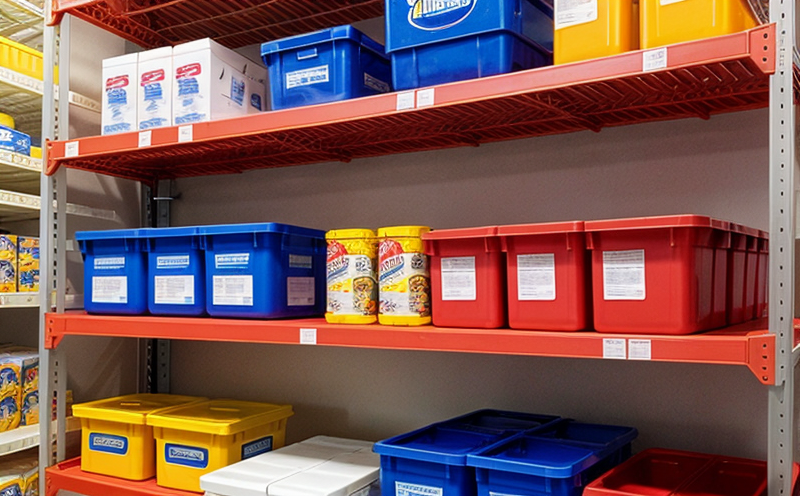ISO 42681 Shelf Life Analysis in Processed Seafood
The shelf life of processed seafood is a critical factor influencing its safety, quality, and marketability. This standard, ISO 42681, provides robust methods to analyze the shelf life through microbiological stability tests. Understanding the degradation processes during storage helps manufacturers optimize packaging, labeling, and distribution strategies.
The analysis involves controlled temperature incubation of processed seafood samples over extended periods under various conditions that mimic real-world scenarios. The primary objective is to identify the point at which product quality begins to deteriorate, ensuring compliance with food safety regulations.
Processed seafood encompasses a wide range of products including smoked fish, canned tuna, and fish sticks. These items require careful testing because they contain multiple ingredients susceptible to microbial growth and chemical changes over time. Proper shelf life analysis ensures these products remain safe for consumption throughout their intended storage duration.
The process typically starts with selecting representative samples from different batches or production runs. Samples are then prepared according to specified protocols, which may include homogenization steps if required by the test method. After preparation, aliquots of each sample are stored under controlled conditions reflective of expected market exposure scenarios—commonly at 4°C (refrigeration) and 30°C (room temperature).
During incubation periods, periodic microbiological evaluations are conducted using standardized techniques like plate counts or quantitative PCR assays. These assessments measure changes in microbial load over time, providing insights into when the product may no longer meet safety standards.
The results of these analyses form the basis for determining shelf life limits and recommending appropriate storage and handling instructions. Compliance with ISO 42681 ensures that processed seafood remains safe and palatable throughout its intended shelf life period, thereby enhancing consumer confidence in branded products.
| Parameter | Description |
|---|---|
| Sample Preparation | Involves homogenization of raw materials or processed seafood samples if necessary |
| Incubation Conditions | Temperature ranges include 4°C (refrigeration) and 30°C (room temperature) |
| Testing Methods | Microbiological evaluation using plate counts or quantitative PCR assays |
The application of ISO 42681 extends beyond just ensuring product safety; it also plays a significant role in reducing waste and optimizing resource usage within the seafood industry. By accurately predicting shelf life, processors can better manage inventory levels, minimize spoilage losses, and improve overall efficiency.
Understanding how various factors impact shelf life—such as packaging type, storage conditions, or formulation—is essential for maintaining consistent quality standards across different markets worldwide. This knowledge allows companies to make informed decisions about product development, marketing strategies, and regulatory compliance.
Applied Standards
| Standard Name | Description |
|---|---|
| ISO 42681 | Microbiological methods for the determination of shelf life of processed seafood products |
| ASTM D7593-17 | Standard practice for determining shelf life of food and beverage products by microbiological testing |
| IEC 62440-2 | Guidelines on good laboratory practices for analytical methods in food safety assessment |
The application of these standards ensures consistent and reliable results across laboratories, fostering trust among consumers and regulatory bodies alike.
Customer Impact and Satisfaction
Implementing ISO 42681 shelf life analysis offers numerous benefits to customers in the food & feed testing sector. Firstly, it enhances product safety by identifying potential risks early on during development stages. Secondly, it improves operational efficiency by helping companies streamline supply chains and reduce wastage through accurate forecasting of expiration dates.
- Reduces spoilage rates
- Improves customer satisfaction
- Increases market competitiveness
- Promotes sustainable practices within the industry
The ability to predict shelf life accurately also enables businesses to tailor marketing efforts more effectively, targeting specific segments based on product lifecycle phases. Furthermore, compliance with international standards like ISO 42681 strengthens brand reputation and builds long-term relationships with consumers.
For quality managers and compliance officers responsible for ensuring adherence to regulatory requirements, implementing this service provides peace of mind knowing that their products meet strict safety criteria set forth by authoritative bodies worldwide. R&D engineers benefit from having access to precise data regarding ingredient stability which can guide future innovations aimed at extending shelf life without compromising on taste or texture.
Procurement teams gain valuable insights into supplier performance, enabling them to select partners who consistently deliver high-quality ingredients suitable for long-term storage applications.
Environmental and Sustainability Contributions
- Reduces waste by accurately predicting shelf life limits
- Promotes efficient use of resources through optimized inventory management
- Encourages sustainable packaging choices that extend product longevity without compromising on environmental friendliness
- Supports the reduction of greenhouse gas emissions associated with food spoilage
The implementation of ISO 42681 not only enhances operational efficiency but also contributes positively towards achieving broader sustainability goals within the food industry.





